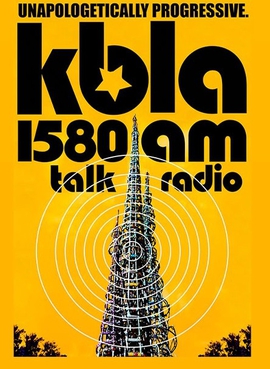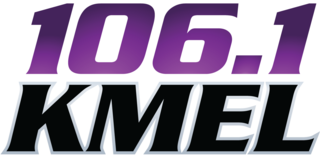Programming
KPOO features music and talk radio from local community activists. The music originally featured was jazz, blues and R&B from the 1950s, 1960s and 1970s.
The Fillmore’s KPOO was an early adopter, launching an all-rap show in 1979. By the mid-80s with the help of young DJ, Marcus Clemmons, KPOO became the center of hip-hop in the Bay Area and beyond. Marcus, who was active from the early 80s into early 90s, helped to create a bridge in rap from the underground to the mainstream by building relationships with the likes of radio programmer Joe Rudolph, Compton rapper Eazy-E and Russell Simmons to name a few.
In the summer of 1982, KPOO started playing rap music on Sunday afternoons from 3pm-7pm with DJ LeBaron Lord King.
Acts like Run-DMC, Public Enemy, Tupac, Paris, as well as Eric B and Rakim all made an appearance at the station or on the air waves. [3]
KPOO now broadcasts local public commentaries and talk programs with community and national Black leaders discussing what's going on in the Black community locally and nationally. The focus on the community continues with commentaries on a variety of talk and music programs. Some of the featured music programming includes salsa, jazz, blues, rap/hip hop, Latin, gospel and reggae, as well as an American Indian talk/music program, and local and national musicians host weekly music programs.
The new school of hip hop was a movement in hip hop music, beginning in 1983–84 with the early records of Run–D.M.C., Whodini, and LL Cool J. Predominantly from Queens and Brooklyn, it was characterized by Drum Machine-led minimalism, often tinged with elements of Rock; rapped taunts, boasts, and socio-political commentary; and aggressive, self-assertive delivery. In song and image, its artists projected a tough, cool, street B-boy attitude. These elements contrasted sharply with Funk and Disco, Novelty hits, live bands, synthesizers, and party rhymes of artists prevalent in the early 1980s. Compared to their older hip hop counterparts, new school artists crafted more cohesive LPs and shorter songs more amenable to airplay. By 1986, their releases began to establish hip hop in the mainstream.

Eric B. & Rakim were an American hip hop duo formed on Long Island, New York, in 1986, composed of DJ Eric B. and rapper Rakim. They first received acclaim for their 1987 debut album Paid in Full, which featured versions of the popular singles "Eric B. Is President" and the title track. They followed with three successful albums: Follow the Leader (1988), Let the Rhythm Hit 'Em (1990), and Don't Sweat the Technique (1992).
Pinoy hip hop or Filipino hip-hop is a style of hip hop music performed by musicians of Filipino descent, especially Filipino-Americans.

Yo! MTV Raps is an American two-hour television music video program, which first aired on MTV Europe from 1987 to mid-90s and on MTV US from August 1988 to August 1995. The American version of the program was the first hip hop music show on the network, and was based on the original MTV Europe show, which first aired one year before the American version. Yo! MTV Raps produced a mix of rap videos, interviews with rap stars, live in-studio performances, and comedy. The show also yielded a Brazilian version called Yo! MTV and broadcast by MTV Brasil from 1990 to 2005.

WHPK is a student-run college radio station owned by the University of Chicagoin Hyde Park on the South Side of Chicago, Illinois.

KBBD is a commercial radio station in Spokane, Washington. It is owned by the Stephens Media Group and broadcasts an adult hits radio format with the slogan is "We Play Whatever". The offices and radio studios are on East 57th Avenue.
WEDR is a radio station serving the South Florida region and licensed to Miami, Florida. WEDR has an unusually wide music selection for an urban contemporary-formatted radio station that ranges from typical hip-hop and R&B to afro beat. This is because South Florida is a very diversified region that has various music tastes. WEDR's studio is located in Hollywood, Florida. The station is owned by Cox Media Group alongside sister stations WHQT, WFEZ and WFLC.

KDAY is a radio station that is licensed to Redondo Beach, California and serves the Greater Los Angeles area. The station is owned by Meruelo Media and airs a classic hip hop format. The station's studios are located in Burbank and its transmitter is in Baldwin Hills. KDAY also extends its signal coverage into the Inland Empire by adding a full power simulcast, KDEY-FM in Ontario, California to fill in all of the overlapping and gaping issues and problems in its eastern coverage area.

Golden age hip hop refers to hip hop music created from the mid or mid-late 1980s to the early or early-mid 1990s, particularly by artists and musicians originating from the New York metropolitan area. A precursor to the new-school hip hop movement, it is characterized by its diversity, quality, innovation and influence on overall hip hop after the genre's emergence and establishment in the old-school era, and is associated with the development and eventual mainstream success of hip hop. There were various types of subject matter, while the music was experimental and the sampling from old records was eclectic.

KRCD is a commercial FM radio station licensed to Inglewood, California, and broadcasting to Greater Los Angeles Area.

KBOO is a non-commercial, listener-supported, community radio station in Portland, Oregon. It airs an eclectic radio format, with a small paid staff and scores of volunteers. The studios are on SE 8th Avenue, in a converted warehouse in inner Southeast Portland, purchased in 1982. The mission is to serve groups that are underrepresented on other local radio stations and to provide access to the airwaves for people who have unconventional or controversial tastes and points of view.

"Renegades of Funk" is a song written by Afrika Bambaataa, Arthur Baker, John Miller & John Robie and recorded by Afrika Bambaataa & Soulsonic Force. Released in 1983 as a single on the Tommy Boy label, it was also included on the 1986 album Planet Rock: The Album. The song is an eclectic fusion of electronic music and heavy percussion, with politically fused hip hop lyrics that draw a connection between past revolutionaries and bohemians to present-day street artists. It was produced and mixed by Arthur Baker and John Robie. Mastering was by Herb Powers Jr..

KBLA is a broadcast radio station in the United States. Licensed to Santa Monica, California, KBLA serves the Greater Los Angeles area. The station is owned by Multicultural Broadcasting, through licensee Multicultural Radio Broadcasting Licensee, LLC, and operated by pending owner Tavis Smiley with an urban/progressive talk format.
KCHU is a non-commercial radio station in Valdez, Alaska, United States. Through its main transmitter, two full-service FM stations, and two translators, the station covers an area the size of the state of Ohio, but with a population just over 10,000.
KYTY is a commercial AM radio station licensed to Somerset, Texas, and serving the San Antonio metropolitan area. It broadcasts a Christian contemporary music format, with some Christian talk and teaching shows. It is also an affiliate of the Houston Astros Radio Network.

KTAO is a solar-powered FM radio station licensed to serve Taos, New Mexico. The station is owned by Taos Communications Corporation. It airs an adult album alternative music format. The station was assigned the KTAO call letters by the Federal Communications Commission on October 6, 1986. The station is an affiliate of the syndicated Pink Floyd program "Floydian Slip."
Lorenzo Wilson Milam, born on August 2, 1933, in Jacksonville, Florida; died on July 19, 2020, in Puerto Escondido, Oaxaca, Mexico, was an American writer and activist who was instrumental in starting many of the first listener-supported community radio stations in the United States, beginning with KRAB in Seattle in 1962.

KMEL is an urban contemporary radio station that is licensed to San Francisco, California, serving the San Francisco Bay Area. It is owned and operated by iHeartMedia.
Hip hop music in Washington, D.C., has been an important part of the culture of the area.
Ron Nelson is a Toronto-based DJ, broadcaster, music promoter, producer, educator, and performer best known for his role in popularizing both hip hop music and later dancehall and reggae music in Canada. He helped promote and develop early Canadian hip hop acts such as Maestro Fresh Wes, Michie Mee, Rumble & Strong and the Dream Warriors.













